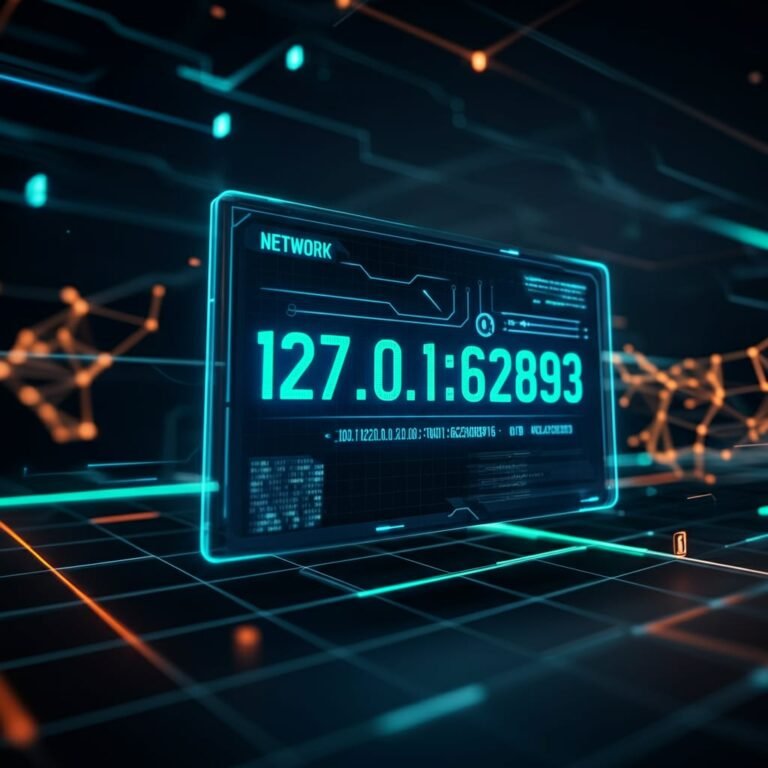The world of networking and software development can seem like a maze of numbers and terms. One such commonly encountered element is 127.0.0.1, often paired with port numbers like 62893. If you’ve ever wondered what this combination means, why it’s significant, and how it’s used, this blog post will guide you through everything you need to know. Whether you’re a software developer, IT professional, or simply a tech enthusiast, you’ll understand how 127.0.0.1:62893 plays a vital role in localized network communication.
What is 127.0.0.1:62893?
Breaking it Down
- 127.0.0.1 refers to the loopback IP address, often called “localhost.” This special IP address is used to refer to the computer or device you’re currently using.
- 62893 is a port number, often dynamically allocated, which helps handle specific network services or communication channels.
Essentially, 127.0.0.1 routes back to your own computer, while the port number directs traffic to a particular service or application running on that device. Together, they form a combination enabling testing, communication, and application deployment in a controlled, local environment.
Why is 127.0.0.1 Important?
The Significance of the Loopback Address
The loopback address, 127.0.0.1, is a key tool in networking, allowing developers and systems to refer to their own machines without involving external networks. It eliminates latency issues and ensures a stable, reliable environment for internal testing.
- Built-in Testing Environment: Developers use 127.0.0.1 to test applications without the need for external connectivity.
- Enhanced Security: Because it works entirely within a local system, loopback traffic is isolated from external networks, reducing vulnerabilities.
- System Troubleshooting: IT administrators use localhost to isolate network or system issues, ruling out external problems.
The Use of Port 62893 in Communication
Decoding Port Numbers
Port numbers act as sub-addresses within a system, directing traffic to specific applications or services. A port like 62893 is dynamically assigned by your operating system. Together with 127.0.0.1, it ensures that messages are routed to the proper application on the local machine.
For example:
- A developer testing a web application on localhost typically receives traffic on port 8080.
- Meanwhile, 62893 might correspond to a temporary server connection established for a specific purpose, such as testing a particular backend API.
The combination of an IP address and port number constitutes a socket, which acts as the endpoint for communication.
How is 127.0.0.1:62893 Used in Software Development?
Practical Applications in Development
- API Testing
Developers use 127.0.0.1:62893 to test APIs in a safe, controlled environment. It simulates real-world conditions without exposing code or data to public networks.
- Web Development Environments
Many modern frameworks, like Django or Node.js, rely on localhost during development. Temporary ports like 62893 are assigned by the server software to test various features.
- Database Connection Testing
Testing local databases, such as SQLite or MySQL, frequently occurs through localhost. Pairing it with unique port numbers allows developers to manage multiple connections simultaneously.
Real-life Example
Imagine a scenario where you’re developing a chatbot application. You might run the bot on localhost at 127.0.0.1, while the service connected to the bot (e.g., a REST API) operates on port 62893. This setup allows you to test and fine-tune every interaction locally before deploying to a live server.
Tips for Troubleshooting Using 127.0.0.1
When working with 127.0.0.1 and dynamic ports like 62893, you may encounter certain challenges. Here’s how to troubleshoot effectively:
- Check Service Availability
Use command-line tools like `netstat` (Windows) or `lsof` (Mac/Linux) to verify which application is bound to port 62893.
- Identify Conflicts
When two applications attempt to use the same port number, conflicts may arise. Resolve this by reconfiguring the conflicting service to use a different port.
- Firewall Settings
Ensure your firewall isn’t blocking localhost traffic. Allow loopback traffic if you’re unable to connect.
- Restart the Service
A simple stop/restart can often resolve issues with dynamically assigned ports.
- Check Configuration Files
Validate that the application’s configuration file points to the correct IP address (127.0.0.1) and port number (62893).
Future Prospects in Network Communication
The Evolving Role of Localhost
While the loopback address and dynamic port allocation are robust tools, advances in network communication are driving innovations:
- Local Containerization
With tools like Docker and Kubernetes, localhost is increasingly used to host containerized applications for distributed systems.
- AI in Network Traffic Management
AI is streamlining traffic allocation and monitoring, even in local networks, ensuring optimum port usage.
- IPv6 Integration
Hosting services may eventually favor IPv6 loopback addresses (e.g., `::1`) for improved scalability and compatibility.
These trends will enhance the usability and efficiency of configurations like 127.0.0.1:62893.
Why 127.0.0.1 with Port Numbers Like 62893 Matters
The combination of 127.0.0.1 and a dynamic port number like 62893 serves as the backbone of localized software testing and development. Whether you’re deploying a new web application, diagnosing system errors, or simulating interactions in a secure setting, this simple setup is indispensable.
By leveraging the power of localhost, developers and IT professionals can work smarter, troubleshoot faster, and build better systems—without the chaos of live environments. The next time you see 127.0.0.1 flash across your terminal, you’ll know it’s more than just numbers. It’s a key enabler of innovation and progress in the digital world.

